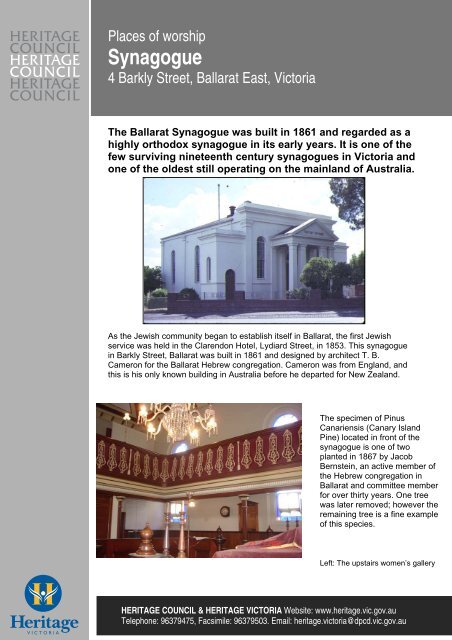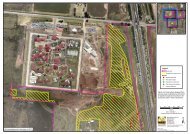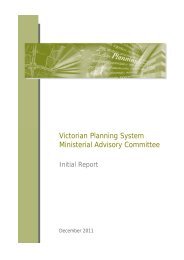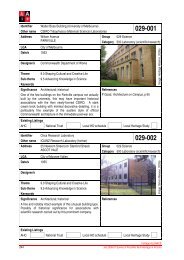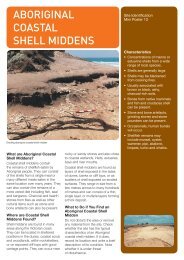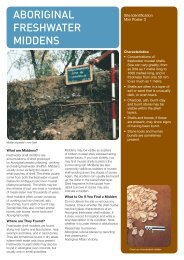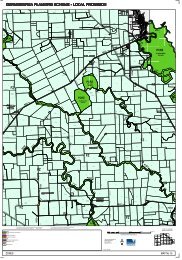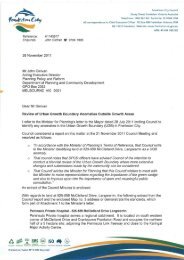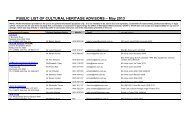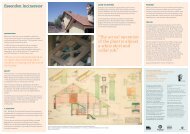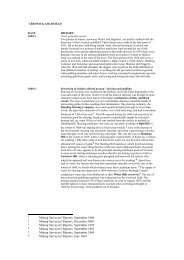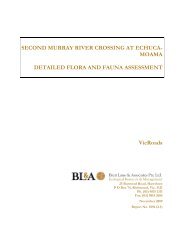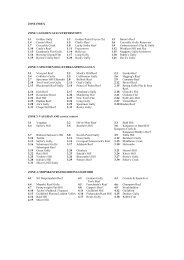Ballarat Synagogue
Ballarat Synagogue
Ballarat Synagogue
Create successful ePaper yourself
Turn your PDF publications into a flip-book with our unique Google optimized e-Paper software.
Male<br />
Places of worship<br />
<strong>Synagogue</strong><br />
4 Barkly Street, <strong>Ballarat</strong> East, Victoria<br />
The <strong>Ballarat</strong> <strong>Synagogue</strong> was built in 1861 and regarded as a<br />
highly orthodox synagogue in its early years. It is one of the<br />
few surviving nineteenth century synagogues in Victoria and<br />
one of the oldest still operating on the mainland of Australia.<br />
As the Jewish community began to establish itself in <strong>Ballarat</strong>, the first Jewish<br />
service was held in the Clarendon Hotel, Lydiard Street, in 1853. This synagogue<br />
in Barkly Street, <strong>Ballarat</strong> was built in 1861 and designed by architect T. B.<br />
Cameron for the <strong>Ballarat</strong> Hebrew congregation. Cameron was from England, and<br />
this is his only known building in Australia before he departed for New Zealand.<br />
The specimen of Pinus<br />
Canariensis (Canary Island<br />
Pine) located in front of the<br />
synagogue is one of two<br />
planted in 1867 by Jacob<br />
Bernstein, an active member of<br />
the Hebrew congregation in<br />
<strong>Ballarat</strong> and committee member<br />
for over thirty years. One tree<br />
was later removed; however the<br />
remaining tree is a fine example<br />
of this species.<br />
Left: The upstairs women’s gallery<br />
HERITAGE COUNCIL & HERITAGE VICTORIA Website: www.heritage.vic.gov.au<br />
Telephone: 96379475, Facsimile: 96379503. Email: heritage.victoria@dpcd.vic.gov.au
Heritage Council of Victoria<br />
Heritage Victoria<br />
Level 7, 8 Nicholson Street<br />
East Melbourne,<br />
Victoria 3002,<br />
Australia<br />
Telephone: 03 96379475<br />
Facsimile: 03 96379503<br />
www.heritage.vic.gov.au<br />
Published by Heritage Council of<br />
Victoria, April 2008.<br />
Also published on<br />
www.heritage.vic.gov.au<br />
© The Heritage Council of Victoria<br />
2008. This publication is copyright. No<br />
part may be reproduced by any<br />
process except in accordance with the<br />
provisions of the Copyright Act 1968.<br />
Authorised by the Heritage Council,<br />
8 Nicholson Street, East Melbourne.<br />
Disclaimer<br />
This publication may be of assistance<br />
to you but the State of Victoria and its<br />
employees do not guarantee that the<br />
publication is without flaw of any kind<br />
or is wholly appropriate for your<br />
particular purposes and therefore<br />
disclaims all liability for any error, loss<br />
or other consequence which may<br />
arise from you relying on any<br />
information in this publication.<br />
T<br />
The <strong>Synagogue</strong> is a single<br />
storey rectangular building<br />
designed in a simple<br />
Renaissance Revival style<br />
with a pedimented portico.<br />
The paired Tuscan squared<br />
columns and pilasters support<br />
the portico, the tympanum of<br />
which contains the name of<br />
the congregation, ‘Remnant of<br />
Israel’ in Hebrew characters.<br />
By the 1870s, Jews were<br />
relatively more numerous in<br />
<strong>Ballarat</strong> than in other Victorian<br />
towns and as a community<br />
they strongly influenced<br />
business life in the town.<br />
The <strong>Synagogue</strong> was<br />
extensively remodelled in<br />
1878. It was originally<br />
constructed in face brickwork,<br />
with contrast provided by<br />
rendered pilasters, columns,<br />
pediment, window reveals<br />
and cornice.<br />
The 1878 remodelling<br />
included the extension of the<br />
women’s gallery along the<br />
sides of the hall, and the<br />
addition of a second staircase<br />
to the gallery and ante-rooms<br />
towards the front of the<br />
building.<br />
The interior of the building is<br />
significant for its intact<br />
furniture and fittings, including<br />
a cedar Bimah, galleries with<br />
cast iron balustrading (top<br />
right) and cedar-fronted Ark<br />
(right).<br />
The Victorian Heritage Register<br />
The Register was established under the Heritage Act<br />
1995 to protect the most significant places in Victoria. It<br />
covers buildings, archaeological sites including<br />
shipwrecks, industrial heritage, cemeteries, heritage<br />
objects, gardens, trees and cultural landscapes. Over<br />
2,000 places and objects are now on the Victorian<br />
Heritage Register.<br />
The Heritage Council of Victoria decides which places<br />
go on the Register, based on established criteria for<br />
heritage values.


